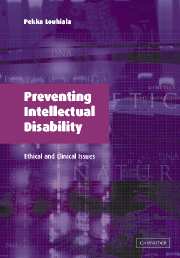Book contents
- Frontmatter
- Contents
- Acknowledgements
- 1 Introduction
- 2 On the definition of intellectual disability?
- 3 Epidemiology of intellectual disability
- 4 Prevention of intellectual disability: general issues
- 5 Prenatal diagnosis and screening
- 6 Genetic counselling
- 7 Why should intellectual disability be prevented?
- 8 Moral status and intellectual disability
- 9 The ethics of prevention in practice: three syndromes
- 10 Conclusion
- References
- Index
8 - Moral status and intellectual disability
Published online by Cambridge University Press: 09 August 2009
- Frontmatter
- Contents
- Acknowledgements
- 1 Introduction
- 2 On the definition of intellectual disability?
- 3 Epidemiology of intellectual disability
- 4 Prevention of intellectual disability: general issues
- 5 Prenatal diagnosis and screening
- 6 Genetic counselling
- 7 Why should intellectual disability be prevented?
- 8 Moral status and intellectual disability
- 9 The ethics of prevention in practice: three syndromes
- 10 Conclusion
- References
- Index
Summary
What is moral status?
The concept of moral status is used widely, yet there are no clear-cut definitions for it. People, animals, things, ideas and the like are referred to as having moral status. It may be low or high and it can be compared (i.e. there are various degrees of moral status). Moral status can also be thought of as intrinsic or conferred.
The vagueness of the concept of moral status is obvious when one looks at the following examples:
X has moral status → It is always wrong to destroy X.
X has moral status → It is prima facie wrong to destroy X.
X has moral status → X has a right to respect (life, help, care, etc.).
X has moral status → Y has a moral obligation with regard to X.
Although moral status seems to escape an exact definition, it is plausible that people in general think along the following lines. If something has moral status it is worthy of moral consideration (Edwards 1997), and we have, or can have, moral obligations towards it (Warren 1997).
The concept of moral status can be thought of as ‘a means of specifying those entities towards which we believe ourselves to have moral obligations, as well as something of what we take those obligations to be’ (Warren 1997, p. 9). The concept is general by nature. We usually ascribe moral status to members of a group, not merely to specific individuals (Warren 1997).
Information
- Type
- Chapter
- Information
- Preventing Intellectual DisabilityEthical and Clinical Issues, pp. 117 - 135Publisher: Cambridge University PressPrint publication year: 2003
